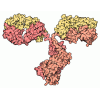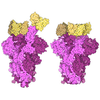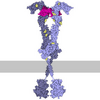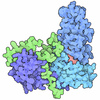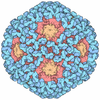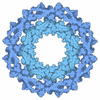Entry Database : PDB / ID : 8udzTitle The Structure of LTBP-49247 Fab Bound to TGFbeta1 Small Latent Complex (LTBP-49247 Fab ...) x 2 Transforming growth factor beta-1 proprotein Keywords / / / / / / Function / homology Function Domain/homology Component
/ / / / / / / / / / / / / / / / / / / / / / / / / / / / / / / / / / / / / / / / / / / / / / / / / / / / / / / / / / / / / / / / / / / / / / / / / / / / / / / / / / / / / / / / / / / / / / / / / / / / / / / / / / / / / / / / / / / / / / / / / / / / / / / / Biological species Homo sapiens (human)Method / / / Resolution : 2.21 Å Authors Streich Jr., F.C. / Nicholls, S.B. / Boston, C.J. / Ramachandran, S. Funding support Organization Grant number Country Other private
Journal : Sci.Signal. / Year : 2024Title : An antibody that inhibits TGF-beta 1 release from latent extracellular matrix complexes attenuates the progression of renal fibrosis.Authors: Jackson, J.W. / Streich Jr., F.C. / Pal, A. / Coricor, G. / Boston, C. / Brueckner, C.T. / Canonico, K. / Chapron, C. / Cote, S. / Dagbay, K.B. / Danehy Jr., F.T. / Kavosi, M. / Kumar, S. / ... Authors : Jackson, J.W. / Streich Jr., F.C. / Pal, A. / Coricor, G. / Boston, C. / Brueckner, C.T. / Canonico, K. / Chapron, C. / Cote, S. / Dagbay, K.B. / Danehy Jr., F.T. / Kavosi, M. / Kumar, S. / Lin, S. / Littlefield, C. / Looby, K. / Manohar, R. / Martin, C.J. / Wood, M. / Zawadzka, A. / Wawersik, S. / Nicholls, S.B. / Datta, A. / Buckler, A. / Schurpf, T. / Carven, G.J. / Qatanani, M. / Fogel, A.I. History Deposition Sep 29, 2023 Deposition site / Processing site Revision 1.0 Jul 17, 2024 Provider / Type Revision 1.1 Nov 20, 2024 Group / Category / pdbx_modification_feature / Item
Show all Show less
 Yorodumi
Yorodumi Open data
Open data Basic information
Basic information Components
Components Keywords
Keywords Function and homology information
Function and homology information Homo sapiens (human)
Homo sapiens (human) X-RAY DIFFRACTION /
X-RAY DIFFRACTION /  SYNCHROTRON /
SYNCHROTRON /  MOLECULAR REPLACEMENT / Resolution: 2.21 Å
MOLECULAR REPLACEMENT / Resolution: 2.21 Å  Authors
Authors United States, 1items
United States, 1items  Citation
Citation Journal: Sci.Signal. / Year: 2024
Journal: Sci.Signal. / Year: 2024 Structure visualization
Structure visualization Molmil
Molmil Jmol/JSmol
Jmol/JSmol Downloads & links
Downloads & links Download
Download 8udz.cif.gz
8udz.cif.gz PDBx/mmCIF format
PDBx/mmCIF format pdb8udz.ent.gz
pdb8udz.ent.gz PDB format
PDB format 8udz.json.gz
8udz.json.gz PDBx/mmJSON format
PDBx/mmJSON format Other downloads
Other downloads 8udz_validation.pdf.gz
8udz_validation.pdf.gz wwPDB validaton report
wwPDB validaton report 8udz_full_validation.pdf.gz
8udz_full_validation.pdf.gz 8udz_validation.xml.gz
8udz_validation.xml.gz 8udz_validation.cif.gz
8udz_validation.cif.gz https://data.pdbj.org/pub/pdb/validation_reports/ud/8udz
https://data.pdbj.org/pub/pdb/validation_reports/ud/8udz ftp://data.pdbj.org/pub/pdb/validation_reports/ud/8udz
ftp://data.pdbj.org/pub/pdb/validation_reports/ud/8udz F&H Search
F&H Search Links
Links Assembly
Assembly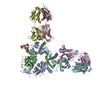
 Components
Components Homo sapiens (human) / Plasmid: pTT5 / Cell (production host): EPITHELIAL / Cell line (production host): Expi293F GnTI- Cells / Organ (production host): KIDNEY / Production host:
Homo sapiens (human) / Plasmid: pTT5 / Cell (production host): EPITHELIAL / Cell line (production host): Expi293F GnTI- Cells / Organ (production host): KIDNEY / Production host:  Homo sapiens (human) / Strain (production host): Expi293F GnTI- Cells / Tissue (production host): KIDNEY / Variant (production host): GnTI- Cells
Homo sapiens (human) / Strain (production host): Expi293F GnTI- Cells / Tissue (production host): KIDNEY / Variant (production host): GnTI- Cells Homo sapiens (human) / Plasmid: pTT5 / Cell (production host): EPITHELIAL / Cell line (production host): Expi293F GnTI- Cells / Organ (production host): KIDNEY / Production host:
Homo sapiens (human) / Plasmid: pTT5 / Cell (production host): EPITHELIAL / Cell line (production host): Expi293F GnTI- Cells / Organ (production host): KIDNEY / Production host:  Homo sapiens (human) / Strain (production host): Expi293F GnTI- Cells / Tissue (production host): KIDNEY / Variant (production host): GnTI- Cells
Homo sapiens (human) / Strain (production host): Expi293F GnTI- Cells / Tissue (production host): KIDNEY / Variant (production host): GnTI- Cells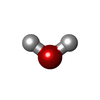

 Homo sapiens (human) / Gene: TGFB1, TGFB / Plasmid: pTT5 / Cell (production host): EPITHELIAL / Cell line (production host): Expi293F GnTI- Cells / Organ (production host): KIDNEY / Production host:
Homo sapiens (human) / Gene: TGFB1, TGFB / Plasmid: pTT5 / Cell (production host): EPITHELIAL / Cell line (production host): Expi293F GnTI- Cells / Organ (production host): KIDNEY / Production host:  Homo sapiens (human) / Strain (production host): Expi293F GnTI- Cells / Tissue (production host): KIDNEY / Variant (production host): GnTI- Cells / References: UniProt: P01137
Homo sapiens (human) / Strain (production host): Expi293F GnTI- Cells / Tissue (production host): KIDNEY / Variant (production host): GnTI- Cells / References: UniProt: P01137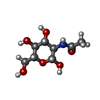
 X-RAY DIFFRACTION / Number of used crystals: 1
X-RAY DIFFRACTION / Number of used crystals: 1  Sample preparation
Sample preparation SYNCHROTRON / Site:
SYNCHROTRON / Site:  APS
APS  / Beamline: 23-ID-D / Wavelength: 1.0332 Å
/ Beamline: 23-ID-D / Wavelength: 1.0332 Å Processing
Processing MOLECULAR REPLACEMENT / Resolution: 2.21→73.5 Å / Cross valid method: FREE R-VALUE / Stereochemistry target values: MAXIMUM LIKELIHOOD
MOLECULAR REPLACEMENT / Resolution: 2.21→73.5 Å / Cross valid method: FREE R-VALUE / Stereochemistry target values: MAXIMUM LIKELIHOOD Movie
Movie Controller
Controller


 PDBj
PDBj